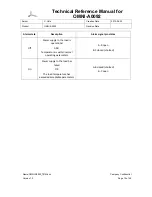
Technical Reference Manual for
OMNI-A0092
Author
C. Vale
Creation Date
2010-04-29
Product
OMNI-A0092
Revision Date
Name:OMNI-A0092_TRM.doc
Company Confidential
Version 1.0
Page 10 of 55
possible.
2.1.1.5
RF Installation
The main antenna assembly houses the antenna matching unit (AMU). There are four N-
connector ports on the AMU. The RF installation of the load is covered later in section 2.2.2.2
and utilises one of the ports on the AMU.
The port on the AMU which feeds the OMNI-A0092 is labelled „TO: TRANSMITTER
(MONOCONE)‟. RF cable is provided to connect the antenna to the transmitter. The cable is
to be routed through the provided hole in the base plate of the main antenna assembly. The
cable should not be pinched or over-bent during installation.
An auxiliary port is also provided on the AMU to interface to an auxiliary antenna. The port
labelled „TO: TRANSMITTER (AUX ANTENNA)‟ can be connected via the provided length
of RF cable to the transmitter. Cable leading to the auxiliary antenna from the provided port
on the top lid of the AMU is not provided.
Should the provided RF cable not be of sufficient length or become damaged, they can be
replaced with new or longer cable of similar power handling capacity, close to at least 1.5kW
up to 30MHz for the cable used to power up the OMNI-A0092 antenna, and an adequate
power handling to manage the power to be transmitted to the auxiliary antenna.
A total of three RF cables as well as a pneumatic hose (see section 2.2.1.1) are eventually to
be routed through the fairly small hole in the base plate of the main antenna assembly. The
hole has been kept purposefully small to reduce the probability of water and dust ingress and
to ease the installation of sealant once the cables have been routed. As such, the RF cables
must be fed through the hole one at a time to ensure that the connectors can clear the hole
once some cables have already been fitted. The pneumatic hose should be fitted through the
hole last. The RF cables should be secured to the base plate using the P-clips provided and the
hole in the base plate should finally be sealed once the antenna system has been tested.












































